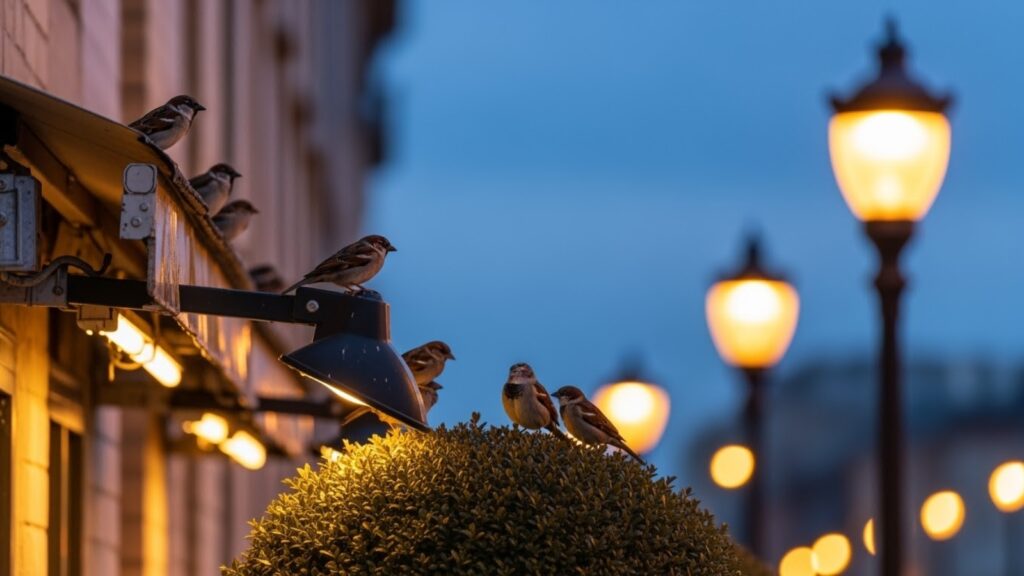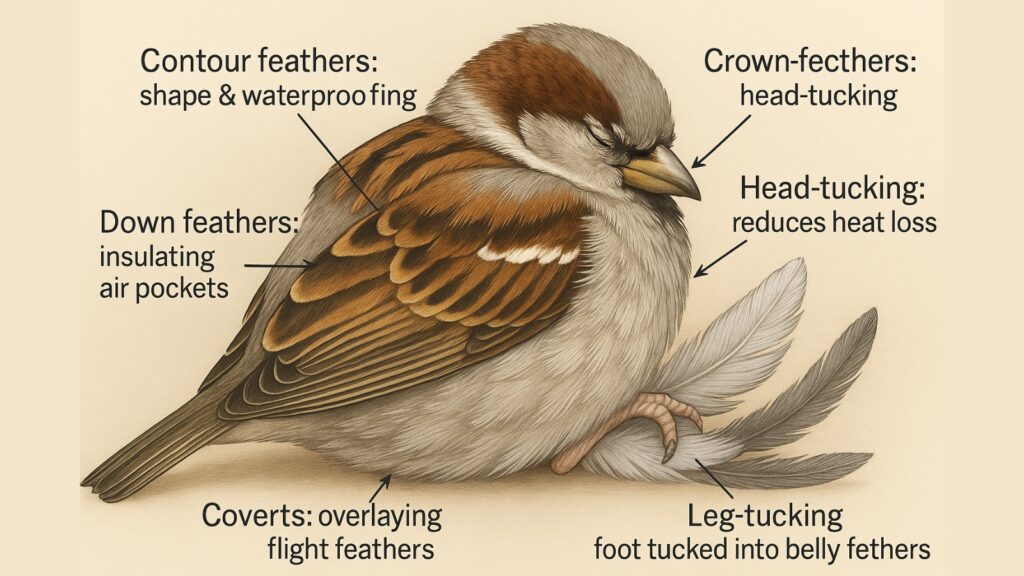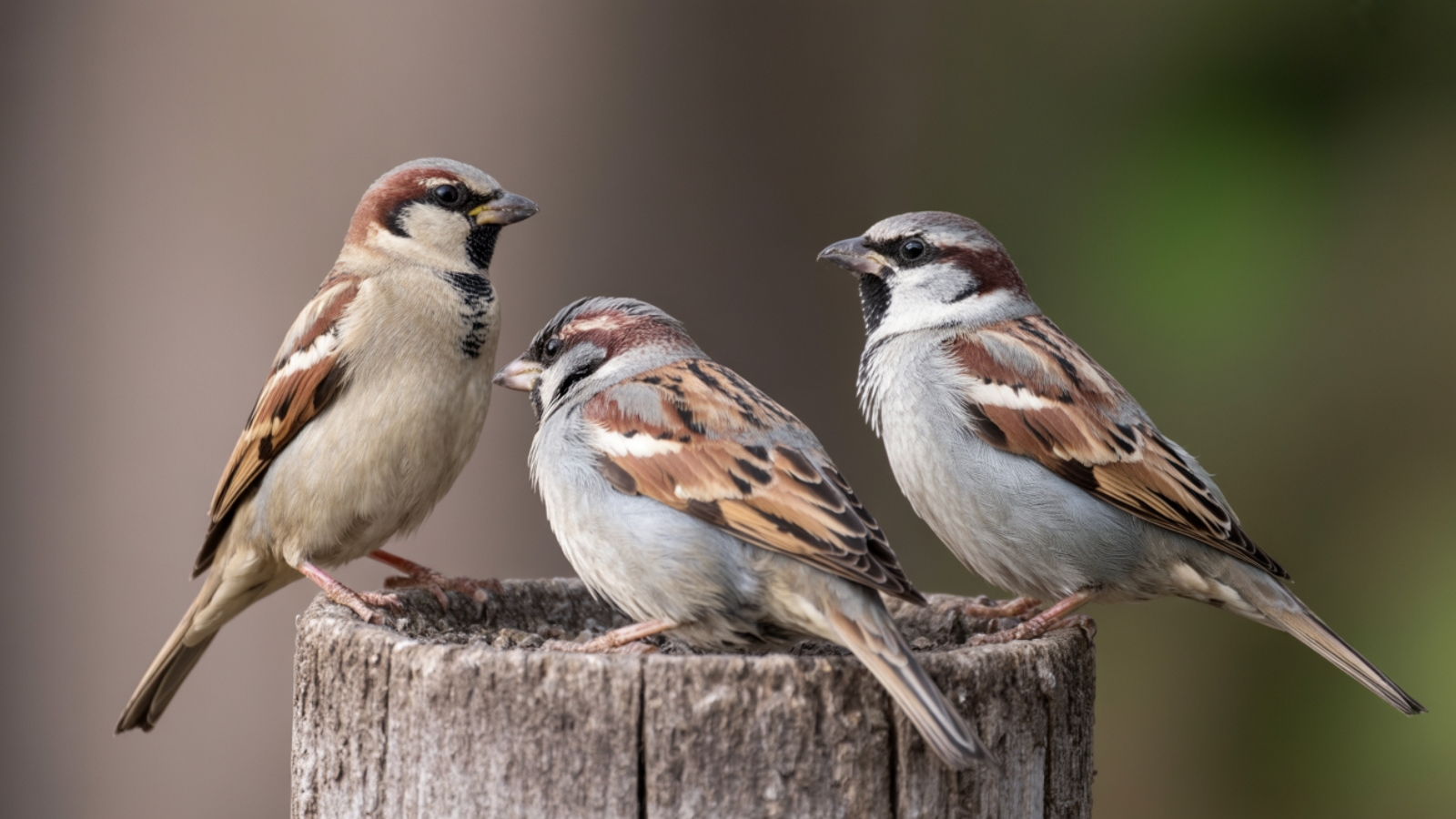House sparrows are diurnal birds that sleep at night, typically roosting in dense vegetation, building cavities, or communal roost sites. They begin settling into their roosting spots approximately 1-1.5 hours before sunset and remain relatively inactive until sunrise. During winter months, they often engage in communal roosting behaviour to conserve body heat, which can reduce energy expenditure by 11-13% based on measured studies.
House sparrows (Passer domesticus) are among the most familiar birds worldwide, yet their nocturnal behaviour remains largely hidden from human observation. Understanding what these adaptable birds do during darkness provides fascinating insights into their survival strategies, social structures, and physiological adaptations. This comprehensive guide explores the evening routines, sleep patterns, and nighttime behaviours that enable house sparrows to thrive in diverse environments across the globe, from urban centres to rural landscapes.
Key Takeaways
- House sparrows are strictly diurnal, becoming inactive from sunset to sunrise with highly predictable timing patterns
- They engage in complex pre-roosting behaviours, including communal gathering, feeding, and maintenance activities
- Roosting site selection varies seasonally, with dense vegetation preferred and communal roosts more common during winter
- Energy conservation through communal roosting can reduce individual expenditure by 11-13% in controlled studies
- Urban environments have modified traditional roosting patterns whilst maintaining core survival strategies
- Social hierarchies significantly influence roosting site selection and positioning within roost sites.
How Do House Sparrows Prepare for Night?
Evening Transition and Pre-Roosting Activities
House sparrows begin their transition to nighttime approximately 1-1.5 hours before sunset, with peak activity occurring 30 minutes before sunset. During this critical period, they engage in several preparatory behaviours that ensure their survival through the night. Feeding activity intensifies as sparrows attempt to maximise energy stores before the long fast ahead. This behaviour, known as “compensatory feeding,” allows them to build sufficient fat reserves to maintain body temperature throughout the night.
Social interactions also peak during pre-roosting periods. Sparrows often gather in loose flocks ranging from 3-40 individuals, engaging in communal preening, sand baths, bill rubbing, and fluffing activities. These gatherings serve multiple purposes: they reinforce social bonds, allow for information exchange about food sources, and provide safety in numbers as the birds prepare for their vulnerable sleeping period.
Territorial Dynamics and Site Competition
Territorial disputes may occur during pre-roosting time as individual birds compete for prime roosting locations. Dominant males typically secure the most protected and thermally advantageous spots, whilst subordinate individuals must settle for less optimal positions. This hierarchy influences not only immediate survival but also long-term breeding success and social status within the flock.
Where Do House Sparrows Sleep?
Natural Roosting Environments
House sparrows demonstrate remarkable flexibility in their choice of nighttime roosting sites, adapting to both natural and urban environments. In natural settings, dense shrubs, hedgerows, and thick vegetation provide ideal roosting locations. Research indicates that house sparrows prioritise foliage density over specific plant species when selecting roosting sites. Understanding why there are lots of sparrows in your garden can help you identify the optimal vegetation structure they seek for both feeding and roosting.
The key selection criterion is vegetation structure rather than particular botanical species. Dense bushy vegetation offers superior protection compared to trees with only dense canopy coverage, providing essential shelter from predators, wind, and precipitation whilst maintaining adequate ventilation. Whilst various plant species may be utilised, no peer-reviewed studies have documented specific Latin binomial preferences for roosting sites.

Urban Roosting Adaptations
Urban environments have significantly expanded roosting opportunities for house sparrows. Building eaves, roof spaces, wall cavities, street light fixtures, and dense ornamental plantings now serve as primary roosting sites for city-dwelling populations. These artificial structures often provide superior protection from weather compared to natural sites, though they may lack some thermal benefits of communal natural roosts.
Street lighting influences site selection patterns, with some birds showing preference for dimly lit areas whilst others demonstrate tolerance for moderate artificial illumination. This flexibility has enabled house sparrows to colonise urban environments successfully, though excessive light pollution can disrupt natural sleep patterns.
What Happens During Winter Roosting?
Communal Roosting Behaviour
Winter roosting behaviour differs markedly from breeding season patterns. During cold months, sparrows form communal roosts in sheltered locations such as nest boxes, building cavities, dense vegetation, or even streetlights in urban areas.
The social thermoregulation provided by communal roosting delivers measurable energy savings. Classic research studies demonstrate that communal roosting in nest boxes half-filled with nesting material can reduce heat loss by 11-13% at temperatures ranging from -8°C to -30°C. This energy conservation proves crucial for winter survival when food sources are limited and ambient temperatures are lowest.
Site Flexibility and Adaptation
When original roosting sites become unavailable due to vegetation removal, trimming, or presence of larger avian species, house sparrows readily relocate to alternative locations. The average distance to secondary roosting sites is approximately 0.22 kilometres, demonstrating their ability to adapt quickly to changing environmental conditions.
Snow and freezing temperatures may force sparrows to seek alternative roosting sites, including human-made structures such as barns, garages, or heated buildings. Some populations have been observed utilising street lamps or other artificial heat sources during extreme weather events, showcasing their remarkable behavioural plasticity.
How Do House Sparrows Sleep?
Sleep Architecture and Patterns
House sparrows enter a state of reduced activity during nighttime hours, characterised by decreased metabolic rate, lowered body temperature, and minimal movement. Contrary to earlier misconceptions, birds do experience both rapid eye movement (REM) and non-REM sleep, though their REM episodes are much shorter than mammals, rarely exceeding 16 seconds and comprising approximately 15% of total sleep time.
Sleep in house sparrows is homeostatically regulated, meaning lost sleep can be recovered by sleeping longer or more intensely. Birds maintain a semi-vigilant state during sleep, with the slightest unusual sound or movement capable of triggering immediate awakening and potential flight responses. This balance between rest and survival readiness is essential for their continued survival.
Physiological Adaptations
Thermoregulation presents the greatest challenge during nighttime hours. House sparrows employ several sophisticated strategies to maintain core body temperature. They fluff their feathers to create insulating air pockets, tuck their heads under wing feathers, and draw one leg up into their belly feathers. These behaviours can reduce heat loss by up to 30% compared to normal daytime postures.
Metabolic suppression allows sparrows to reduce energy consumption during the fasting period. Heart rate decreases, breathing slows, and non-essential physiological processes are temporarily reduced. This adaptation proves particularly important given that small birds like house sparrows have high metabolic rates and limited energy storage capacity.
How Do House Sparrows Avoid Predators at Night?
Strategic Site Selection
Nighttime brings increased vulnerability to predators, prompting house sparrows to employ multiple risk-reduction strategies. Roosting site selection prioritises locations offering multiple escape routes and early warning capabilities for approaching threats. Dense vegetation provides essential camouflage, whilst elevated positions offer superior visibility of ground-based predators.
The structural complexity of chosen sites often includes thorny or dense branching that physically deters larger predators from accessing roosting birds. This natural protection, combined with the birds’ quick reflexes and flight capabilities, creates multiple defensive layers.
Group Defence Mechanisms
Communal roosting serves as an effective anti-predator strategy beyond its thermoregulatory benefits. Multiple individuals dramatically increase the likelihood of early threat detection, with the first bird to notice danger alerting the entire group through alarm calls. The confusion effect of a suddenly exploding flock can disorient predators, whilst the statistical advantage means any individual’s chance of predation decreases as group size increases.
Some house sparrow populations engage in heterospecific communal roosting, sharing sites with other small passerine birds. This behaviour further enhances predator detection capabilities whilst distributing risk across multiple species.
What Are the Seasonal Differences in Nighttime Behaviour?
Winter Adaptations
Winter months bring significant changes to house sparrow nighttime behaviour. Longer nights require extended periods of energy conservation, leading to more pronounced metabolic suppression and increased reliance on fat reserves accumulated during brief daylight feeding periods. Communal roosting becomes essential for survival, with birds often arriving at roost sites up to an hour before sunset to secure favourable positions within the group.
Extreme weather conditions may force sparrows to abandon traditional roosting sites in favour of human-made structures offering superior protection. This behavioural flexibility has enabled house sparrow populations to survive in regions with harsh winter climates that would otherwise be unsuitable for year-round residence.
Breeding Season Modifications
Spring and summer bring different challenges and opportunities for house sparrow nighttime behaviour. Longer daylight hours reduce roosting time but increase energy demands due to breeding activities. During breeding season (March through August), mated pairs often roost separately near their nesting territories rather than joining communal roosts. This behaviour differs significantly among types of sparrow birds that you should know, with each species showing unique territorial patterns.
Males frequently sleep close to nest sites to guard their reproductive investment, whilst females occasionally roost within or immediately adjacent to nest cavities. This territorial behaviour ensures protection of eggs and young whilst maintaining pair bonds essential for successful reproduction.
How Have Urban Environments Changed Sparrow Behaviour?
Light Pollution Effects
City-dwelling house sparrows have adapted their nighttime behaviours to accommodate urban environments. Artificial lighting can extend feeding opportunities slightly past natural sunset, though most sparrows continue adhering to traditional diurnal patterns. Some urban populations demonstrate tolerance for illuminated roosting areas, suggesting behavioural adaptation to moderate light pollution. Homeowners wondering is it good to have sparrows in your garden should consider how artificial lighting affects these beneficial garden birds.
However, excessive artificial lighting can disrupt natural sleep patterns and increase stress levels. Research indicates that urban sparrow populations may have altered sleep architecture compared to rural counterparts, though the long-term implications of these changes remain under investigation.
Structural Adaptations
Modern urban development both eliminates traditional roosting sites and creates new opportunities. Building modifications and contemporary architecture often provide fewer suitable cavities and crevices compared to older structures, forcing sparrows to seek alternative locations or compete more intensively for available sites.
Despite these challenges, house sparrows demonstrate remarkable creativity in utilising available urban spaces. They readily adopt ornamental plantings, building fixtures, and artificial structures as roosting sites, showcasing the behavioural flexibility that has enabled their global success.

What Energy Conservation Strategies Do Sparrows Use?
Physical Mechanisms
Energy conservation during nighttime hours proves crucial for house sparrow survival. Beyond behavioural adaptations like reduced movement and strategic positioning, sparrows employ sophisticated physiological mechanisms to minimise energy expenditure. Fat reserves accumulated during daytime feeding sustain birds through the night, with these energy stores proving particularly critical during winter when nights are longest and ambient temperatures lowest. Providing top bird seeds for house sparrows during daylight hours ensures they build sufficient energy stores for nighttime survival.
Young birds and those in poor physical condition face the greatest vulnerability to nighttime energy depletion. Successful energy management often determines survival rates, particularly during harsh weather conditions when food sources may be limited for extended periods.
Social Thermoregulation Benefits
Communal roosting provides energy savings through shared body heat and reduced exposure to harsh conditions. Measured studies show that house sparrows roosting communally in nest boxes can achieve heat savings of 11-13% during extreme cold conditions. The positioning within communal roosts follows social hierarchies, with dominant individuals securing the most thermally advantageous positions.
These measured energy savings, whilst more modest than some theoretical projections, still represent significant survival advantages during harsh winter conditions when every calorie conserved can determine survival outcomes.
Final Thoughts
House sparrows demonstrate remarkable sophistication in their nighttime behaviour, employing complex strategies for survival, energy conservation, and predator avoidance. From careful roosting site selection to physiological adaptations for temperature regulation, these familiar birds navigate the challenges of darkness with evolutionary-honed precision. Understanding their nocturnal habits provides valuable insights into urban wildlife adaptation and the delicate balance between energy conservation and survival in both natural and human-modified environments.
The success of house sparrows across diverse global environments reflects their ability to modify nighttime behaviours according to local conditions whilst maintaining core survival strategies. As urban environments continue evolving, monitoring changes in sparrow nighttime behaviour will provide important indicators of how wildlife adapts to human-dominated landscapes. Supporting house sparrows through thoughtful urban planning, preservation of roosting habitat, and reduction of light pollution can help ensure these adaptable birds continue thriving alongside human communities.
Related Posts
Explore more about house sparrows and garden bird behaviour with these comprehensive guides:
- Sparrow Species Guide – Discover the complete identification guide to sparrow species, their nesting habits, and how to create sparrow-friendly gardens that support their natural behaviours.
- Difference Between a Sparrow and a Dunnock – Learn to distinguish between these similar garden birds, including their unique roosting preferences, nesting patterns, and behavioural differences that affect nighttime habits.
Frequently Asked Questions (FAQ)
Q: What time do house sparrows go to sleep?
A: House sparrows begin settling into roosting sites 1-1.5 hours before sunset, with peak arrival occurring 30 minutes before sunset. They remain inactive until sunrise, when departure typically occurs within 30 minutes to 1 hour after dawn.
Q: Do house sparrows sleep in their nests at night?
A: Adult house sparrows typically do not sleep in their nests outside of the breeding season. They prefer communal roosting sites in dense vegetation or building cavities. During breeding season, females may occasionally roost near or within nest cavities.
Q: How do house sparrows stay warm at night?
A: House sparrows employ multiple warming strategies including fluffing feathers to create insulating air pockets, tucking heads under wing feathers, drawing legs into belly feathers, and roosting communally to share body heat. These behaviours can reduce heat loss by up to 30%.
Q: Do house sparrows migrate or stay year-round?
A: House sparrows are generally non-migratory birds that remain in their territories year-round. They adapt to seasonal changes through modified roosting behaviour, communal gathering, and enhanced energy conservation strategies rather than migration.
Q: What predators threaten house sparrows at night?
A: Nocturnal predators of house sparrows include owls, cats, weasels, and other small carnivores. Sparrows counter these threats through strategic site selection, group roosting for early warning, and maintaining semi-vigilant sleep states.
Q: How many house sparrows roost together?
A: Communal roosts can contain dozens to hundreds of individuals, particularly during winter months. Smaller groups of 3-40 birds are more common, with larger aggregations forming in areas with abundant food sources and suitable roosting habitat.
Q: Can house sparrows see in the dark?
A: House sparrows have limited night vision compared to nocturnal species. They rely primarily on hearing and group vigilance for predator detection during dark hours, which is why they remain largely inactive from sunset to sunrise.
Q: Do house sparrows make noise at night?
A: House sparrows typically remain quiet during nighttime hours. However, they produce distinctive roosting vocalisations when entering roost sites at dusk and upon awakening at dawn. Warning calls may occasionally interrupt nighttime silence if threats are detected.
Q: How long do house sparrows sleep?
A: House sparrows sleep approximately 10-14 hours depending on seasonal day length, remaining inactive from sunset to sunrise. Winter months feature longer sleep periods, whilst summer brings shorter nighttime rest due to extended daylight hours.
Q: What happens if a house sparrow loses its roost site?
A: House sparrows demonstrate remarkable adaptability when roosting sites are lost. They typically relocate to alternative sites within approximately 0.22 kilometres of their original location, utilising secondary plant species or artificial structures as needed.
Q: Do house sparrows hibernate or go into torpor?
A: House sparrows do not hibernate but may enter brief periods of shallow torpor to conserve energy during extremely cold conditions. This involves reduced metabolic rate and body temperature whilst maintaining the ability to respond quickly to threats.
Q: How do urban lights affect house sparrow sleep?
A: Moderate artificial lighting generally doesn’t prevent house sparrows from roosting, though excessive light pollution can disrupt natural sleep patterns and increase stress levels. Urban populations show some tolerance for illuminated roosting areas.
Q: What’s the difference between house sparrow roosting and nesting?
A: Roosting refers to nighttime sleeping behaviour in temporary sites used for rest and protection, whilst nesting involves breeding activities in more permanent structures where eggs are laid and young are raised. Roosting sites change seasonally and daily.
Q: Do house sparrows dream like humans?
A: House sparrows experience REM sleep phases similar to mammals, though their REM episodes are much shorter (rarely exceeding 16 seconds). Whether this constitutes dreaming comparable to human experience remains scientifically uncertain.
Q: How much energy do house sparrows save by roosting together?
A: Controlled studies demonstrate that communal roosting can reduce heat loss by 11-13% in nest boxes during extreme cold conditions (-8°C to -30°C). Whilst modest, these savings can be crucial for winter survival when food sources are limited.
Q: Do house sparrows prefer specific plants for roosting?
A: House sparrows select roosting sites based on foliage density and structural protection rather than specific plant species. They prioritise dense, bushy vegetation that offers shelter from predators and weather, regardless of the particular botanical identity.
External Sources:
- Aulsebrook, A.E., Johnsson, R.D., & Lesku, J.A. (2021). Light, sleep and performance in diurnal birds. Clocks & Sleep.
- BioOne Research (2024). Energy conservation studies in communal roosting birds. BioOne Complete.
- Cornell Lab of Ornithology. (2024). House Sparrow Overview. All About Birds.
- Wikipedia Contributors. (2024). House Sparrow – Roosting Behaviour. Wikipedia.
- Khalilieh, A., McCue, M.D., & Pinshow, B. (2012). Physiological responses to food deprivation in the house sparrow, a species not adapted to prolonged fasting. American Journal of Physiology.
